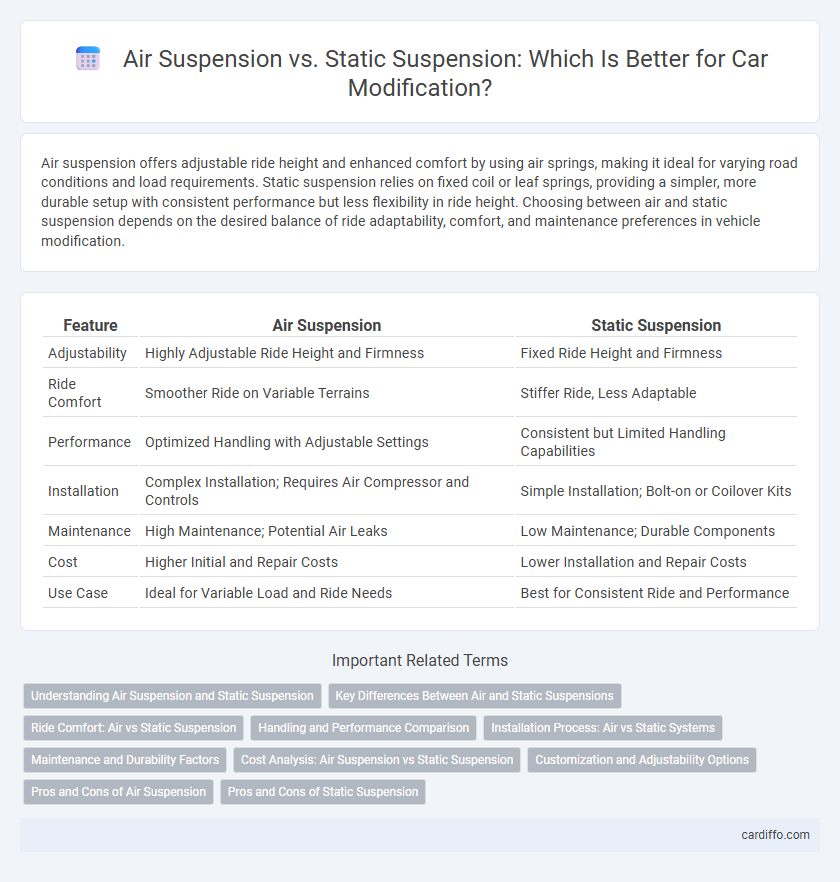Air suspension offers adjustable ride height and enhanced comfort by using air springs, making it ideal for varying road conditions and load requirements. Static suspension relies on fixed coil or leaf springs, providing a simpler, more durable setup with consistent performance but less flexibility in ride height. Choosing between air and static suspension depends on the desired balance of ride adaptability, comfort, and maintenance preferences in vehicle modification.
Table of Comparison
| Feature | Air Suspension | Static Suspension |
|---|---|---|
| Adjustability | Highly Adjustable Ride Height and Firmness | Fixed Ride Height and Firmness |
| Ride Comfort | Smoother Ride on Variable Terrains | Stiffer Ride, Less Adaptable |
| Performance | Optimized Handling with Adjustable Settings | Consistent but Limited Handling Capabilities |
| Installation | Complex Installation; Requires Air Compressor and Controls | Simple Installation; Bolt-on or Coilover Kits |
| Maintenance | High Maintenance; Potential Air Leaks | Low Maintenance; Durable Components |
| Cost | Higher Initial and Repair Costs | Lower Installation and Repair Costs |
| Use Case | Ideal for Variable Load and Ride Needs | Best for Consistent Ride and Performance |
Understanding Air Suspension and Static Suspension
Air suspension uses airbags inflated with compressed air to adjust ride height and improve comfort, offering variable stiffness and adaptability to different road conditions. Static suspension relies on traditional coil springs or leaf springs, providing a fixed ride height and consistent handling characteristics. Understanding the differences helps in choosing between the dynamic flexibility of air suspension and the simplicity and reliability of static suspension for vehicle modification.
Key Differences Between Air and Static Suspensions
Air suspension systems use compressed air to adjust ride height and improve comfort, offering customizable stiffness and load-leveling capabilities. Static suspensions rely on fixed springs and shocks, providing a simpler, more durable setup with consistent performance but limited adjustability. The choice impacts ride quality, handling precision, and vehicle adaptability to varying loads or terrains.
Ride Comfort: Air vs Static Suspension
Air suspension offers superior ride comfort by adjusting air pressure in the airbags to absorb road imperfections, resulting in a smoother, customizable driving experience compared to static suspension. Static suspension uses fixed coil or leaf springs that provide consistent but less adaptive cushioning, often leading to a firmer ride that can transmit more vibrations and bumps to the cabin. The ability of air suspension to adapt to varying loads and road conditions significantly enhances passenger comfort over traditional static setups.
Handling and Performance Comparison
Air suspension offers adjustable ride height and stiffness, allowing for improved handling dynamics by adapting to different driving conditions, which enhances cornering stability and traction. Static suspension systems provide consistent handling characteristics with fixed spring rates and dampers, delivering predictable performance but lacking the adaptability of air setups. Performance-wise, air suspension excels in versatility and comfort balance, while static suspension generally offers superior responsiveness and reduced weight for aggressive driving scenarios.
Installation Process: Air vs Static Systems
Installing air suspension involves integrating compressors, air tanks, and electronic control units, requiring precise routing of air lines and electrical wiring, often demanding more time and technical expertise compared to static suspension. Static suspension installation is generally straightforward, involving replacing springs and shocks without the need for additional components or electronic calibrations. Air systems offer adjustable ride height and comfort through complex installation, while static setups prioritize simplicity and durability with quicker setup times.
Maintenance and Durability Factors
Air suspension systems require regular checks for leaks, compressor function, and airbag condition to maintain optimal performance, making their maintenance more complex than static suspensions. Static suspensions, composed mainly of springs and shock absorbers, generally exhibit greater durability with fewer maintenance demands, resulting in lower long-term upkeep costs. Durability in static suspension is enhanced by simpler mechanical components, while air suspension systems are prone to wear in airbags and compressors, potentially reducing lifespan without meticulous care.
Cost Analysis: Air Suspension vs Static Suspension
Air suspension systems typically incur higher upfront costs, ranging from $2,000 to $5,000 or more, due to complex components like compressors and airbags, while static suspension upgrades usually cost between $500 and $1,500. Maintenance expenses for air suspensions can be significant, including potential air leaks and compressor failures, leading to additional long-term costs compared to the simpler, more durable static setups. When weighing investment decisions, the enhanced ride comfort and adjustability of air suspension must be balanced against initial and ongoing expenses, whereas static suspension offers a cost-effective, low-maintenance alternative for performance improvements.
Customization and Adjustability Options
Air suspension offers superior customization and adjustability options compared to static suspension, allowing drivers to fine-tune ride height and firmness on the fly through electronic controls. Static suspension relies on fixed springs and shocks, which limits adjustment to manual component replacement or preset settings, reducing flexibility in handling different road conditions or load requirements. This dynamic adaptability makes air suspension ideal for enthusiasts seeking personalized ride comfort and performance tailored to various driving scenarios.
Pros and Cons of Air Suspension
Air suspension provides adjustable ride height and improved ride comfort by using air springs that adapt to road conditions and load, making it ideal for varying terrains and load weights. The system's complexity and higher maintenance costs can lead to potential air leaks and failures, increasing long-term expenses compared to static suspension. Static suspension offers durability and simplicity but lacks the customizable ride quality and height adjustment benefits of air suspension systems.
Pros and Cons of Static Suspension
Static suspension offers a lower cost and easier installation compared to air suspension, making it popular among budget-conscious car enthusiasts. However, it lacks the ride adjustability and comfort benefits of air suspension, resulting in a stiffer ride and reduced adaptability to varying road conditions. This suspension type provides consistent handling performance but sacrifices the ability to quickly change ride height or stiffness on demand.
air suspension vs static suspension Infographic

 cardiffo.com
cardiffo.com